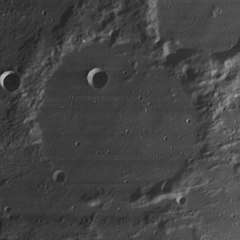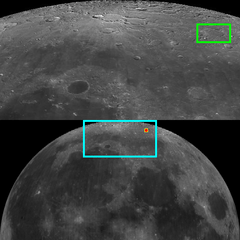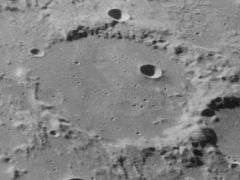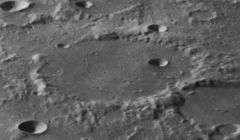Arnold (crater)
Arnold is a lunar impact crater that is located in the north-northeastern part of the visible Moon, near the lunar limb. This location gives the crater a notably oval appearance due to foreshortening, although the formation is actually relatively round. It lies to the northeast of the Mare Frigoris, to the north of the crater Democritus. West of Arnold is the smaller crater Moigno.
 Lunar Orbiter 4 image | |
| Coordinates | 66.8°N 35.9°E |
|---|---|
| Diameter | 95 km |
| Depth | 2.0 km |
| Colongitude | 325° at sunrise |
| Eponym | Christoph Arnold |



The ancient rim of Arnold has been worn and rounded by ages of subsequent bombardment. There is a gap in the wall to the southwest, marked by the tiny crater Arnold J, and the wall is relatively low along the eastern edge. The northern half of the rim is the most intact, particularly to the northeast where is joins the satellite crater Arnold A.
The inner floor of Arnold crater has been resurfaced by lava, and is relatively flat except for a number of tiny craterlets. The most notable crater in the interior is Arnold F, in the northwest section. If the crater once possessed a central peak, no sign of this feature now remains.
Satellite craters
By convention these features are identified on lunar maps by placing the letter on the side of the crater midpoint that is closest to Arnold.
| Arnold | Latitude | Longitude | Diameter |
|---|---|---|---|
| A | 68.8° N | 39.8° E | 57 km |
| E | 71.6° N | 38.3° E | 32 km |
| F | 67.5° N | 35.2° E | 10 km |
| G | 67.3° N | 31.4° E | 11 km |
| H | 72.6° N | 45.3° E | 13 km |
| J | 65.9° N | 33.7° E | 6 km |
| K | 70.8° N | 42.8° E | 29 km |
| L | 70.2° N | 36.1° E | 33 km |
| M | 68.3° N | 43.6° E | 7 km |
| N | 70.2° N | 41.9° E | 18 km |
References
- Andersson, L. E.; Whitaker, E. A. (1982). NASA Catalogue of Lunar Nomenclature. NASA RP-1097.CS1 maint: ref=harv (link)
- Blue, Jennifer (July 25, 2007). "Gazetteer of Planetary Nomenclature". USGS. Retrieved 2007-08-05.CS1 maint: ref=harv (link)
- Bussey, B.; Spudis, P. (2004). The Clementine Atlas of the Moon. New York: Cambridge University Press. ISBN 978-0-521-81528-4.CS1 maint: ref=harv (link)
- Cocks, Elijah E.; Cocks, Josiah C. (1995). Who's Who on the Moon: A Biographical Dictionary of Lunar Nomenclature. Tudor Publishers. ISBN 978-0-936389-27-1.CS1 maint: ref=harv (link)
- McDowell, Jonathan (July 15, 2007). "Lunar Nomenclature". Jonathan's Space Report. Retrieved 2007-10-24.CS1 maint: ref=harv (link)
- Menzel, D. H.; Minnaert, M.; Levin, B.; Dollfus, A.; Bell, B. (1971). "Report on Lunar Nomenclature by the Working Group of Commission 17 of the IAU". Space Science Reviews. 12 (2): 136–186. Bibcode:1971SSRv...12..136M. doi:10.1007/BF00171763.CS1 maint: ref=harv (link)
- Moore, Patrick (2001). On the Moon. Sterling Publishing Co. ISBN 978-0-304-35469-6.CS1 maint: ref=harv (link)
- Price, Fred W. (1988). The Moon Observer's Handbook. Cambridge University Press. ISBN 978-0-521-33500-3.CS1 maint: ref=harv (link)
- Rükl, Antonín (1990). Atlas of the Moon. Kalmbach Books. ISBN 978-0-913135-17-4.CS1 maint: ref=harv (link)
- Webb, Rev. T. W. (1962). Celestial Objects for Common Telescopes (6th revised ed.). Dover. ISBN 978-0-486-20917-3.CS1 maint: ref=harv (link)
- Whitaker, Ewen A. (1999). Mapping and Naming the Moon. Cambridge University Press. ISBN 978-0-521-62248-6.CS1 maint: ref=harv (link)
- Wlasuk, Peter T. (2000). Observing the Moon. Springer. ISBN 978-1-85233-193-1.CS1 maint: ref=harv (link)
| Wikimedia Commons has media related to Image:Lunar_crater_Arnold.png. |
